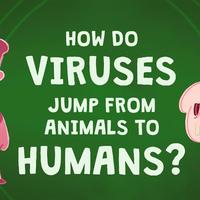How do viruses jump from animals to humans? - Ben Longdon
At a Maryland country fair in 2017,
the prize pigs were not looking their best.
Farmers reported feverish hogs with inflamed eyes and running snouts.
But while fair officials worried about the pigs,
the Maryland department of health was concerned about a group of sick fairgoers.
Some had pet the pigs, while others had merely been near their barns;
but soon, 40 of these attendees would be diagnosed with swine flu.
More often than not, sick animals don't infect humans.
But when they do, these cross-species infections,
or viral host jumps,
have the potential to produce deadly epidemics.
So how can pathogens from one species infect another,
and what makes host jumps so dangerous?
Viruses are a type of organic parasite infecting nearly all forms of life.
To survive and reproduce, they must move through three stages:
contact with a susceptible host, infection and replication,
and transmission to other individuals.
As an example, let's look at human influenza.
First, the flu virus encounters a new host
and makes its way into their respiratory tract.
This isn't so difficult, but to survive in this new body,
the virus must mount a successful infection
before it's caught and broken down by an immune response.
To accomplish this task,
viruses have evolved specific interactions with their host species.
Human flu viruses are covered in proteins
adapted to bind with matching receptors on human respiratory cells.
Once inside a cell, the virus employs additional adaptations
to hijack the host cell's reproductive machinery
and replicate its own genetic material.
Now the virus only needs to suppress or evade the host's immune system
long enough to replicate to sufficient levels and infect more cells.
At this point, the flu can be passed on to its next victim
via any transmission of infected bodily fluid.
However, this simple sneeze also brings the virus in contact with pets,
plants, or even your lunch.
Viruses are constantly encountering new species and attempting to infect them.
More often than not, this ends in failure.
In most cases, the genetic dissimilarity between the two hosts is too great.
For a virus adapted to infect humans,
a lettuce cell would be a foreign and inhospitable landscape.
But there are a staggering number of viruses circulating in the environment,
all with the potential to encounter new hosts.
And because viruses rapidly reproduce by the millions,
they can quickly develop random mutations.
Most mutations will have no effect, or even prove detrimental;
but a small proportion may enable the pathogen to better infect a new species.
The odds of winning this destructive genetic lottery increase over time,
or if the new species is closely related to the virus' usual host.
For a virus adapted to another mammal,
infecting a human might just take a few lucky mutations.
And a virus adapted to chimpanzees,
one of our closest genetic relatives, might barely require any changes at all.
It takes more than time and genetic similarity
for a host jump to be successful.
Some viruses come equipped to easily infect a new host's cells,
but are then unable to evade an immune response.
Others might have a difficult time transmitting to new hosts.
For example, they might make the host's blood contagious,
but not their saliva.
However, once a host jump reaches the transmission stage,
the virus becomes much more dangerous.
Now gestating within two hosts,
the pathogen has twice the odds of mutating into a more successful virus.
And each new host increases the potential for a full-blown epidemic.
Virologists are constantly looking for mutations
that might make viruses such as influenza more likely to jump.
However, predicting the next potential epidemic is a major challenge.
There's a huge diversity of viruses that we're only just beginning to uncover.
Researchers are tirelessly studying the biology of these pathogens.
And by monitoring populations to quickly identify new outbreaks,
they can develop vaccines and containment protocols to stop these deadly diseases.

